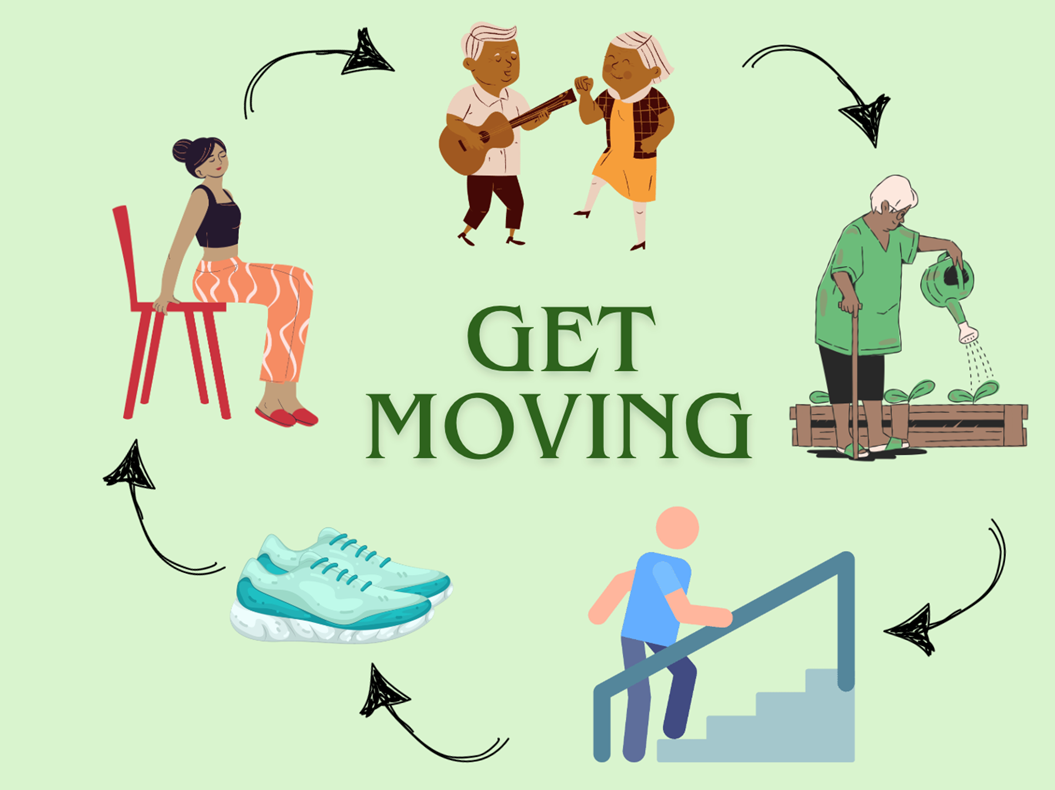[NOTE: This article has been posted prior to peer review for use in an active research program. This content will be updated with a peer reviewed version as soon as it is available.]
Physical activity is broadly defined as any bodily movement produced by skeletal muscles that requires energy expenditure.1 This encompasses a range of activities, from daily chores to sports and exercise. If you are already doing activities such as walking to the mailbox, doing the dishes, folding laundry, walking around the grocery store, etc., you are physically active!
Many individuals with COPD often experience limited physical activity due to shortness of breath, muscle weakness, and fatigue.2 These can limit their ability and perception of physical activity and exercise, leading to limited adherence to exercise recommendations.3 There is often a dichotomous, all or nothing approach, with the current threshold for success defined as 150 minutes or more of moderate-intensity aerobic exercise on most if not all days of the week.4 Patients with COPD experience lower walking time (44 ± 26 vs. 81 ± 26 minutes/day), standing time (191 ± 99 vs. 295 ± 109 minutes/day), and movement intensity during walking (1.8 ± 0.3 vs. 2.4 ± 0.5 m/second2, p < 0.0001 for all), as well as higher sitting time (374 ± 139 vs. 306 ± 108 minutes/day, p = 0.04) and lying time (87 ± 97 vs. 29 ± 33 minutes/day, p = 0.004).5 Patients speak to not having sufficient motivation nor receiving the necessary information from general practitioners about the benefits of physical activity nor negative consequences of an inactive lifestyle.6 Reframing exercise and physical activity as attainable and within reach can make recommendations seem more feasible.
The National Institutes of Health (NIH) recommends a list of tips to get started with physical activity:7
- Pick something you enjoy (walking, dancing, chair yoga)
- Use the talk test to guide intensity, where the talk test is defined as being able to speak a few words in a row, but you should not be able to sing
- Aim for 10 minutes at a time
- Try a short walk after a meal or during a break
- Start with 2-3 days/week
The American Heart Association recommends at least 150 minutes of moderate-intensity physical activity a week.7 This can be divided in any direction (for example 22-30 minutes a day for 5 days). Therefore, creating a plan and using these guidelines to make them work for you is the most important part of saying accountable. The Mayo Clinic created a list of recommendations on how to design a fitness program:8
- Think about your fitness goals and make a balanced routine
- Start slow and go forward slowly
- Aim to increase by 10% a week
- Build activity into your daily routine
- Finding time to exercise can be a challenge. To make it easier, schedule time to exercise as you would a doctor’s appointment
- Use a calendar or phone reminders
- Add movement to things you already do (walk during calls, take stairs, stretch while walking TV)
In a randomized controlled trial, subjects were assigned to exercise-specific self-efficacy enhancing interventions, and they observed that participants increased time with physical activity +20.68 ± 29.30 minutes/day.9 Therefore, as patients improve and increase self-efficacy and self-guidance in physical activity management, it can become more sustainable in adherence.
The NIH also addresses common barriers mentioned in opposition to completing physical activity. These are highlighted below:7
|
I don't have time
|
Monitor your daily activities for 1 week
Find at least 3 30-minute time slots you could use for physical activity
|
|
I don't want to do this alone
|
Join a group, such as a class at the YMCA or a hiking club
|
|
I'm too tired
|
Schedule physical activity for times in the day or week when you feel energetic
Sdd PA to your workday by walking during your lunch break and taking the stairs when possible
|
|
I have so much to do already
|
Make physical activity a regular part of your schedule by writing it on your calendar
|
References
- Caspersen CJ, Powell KE, Christenson GM. Physical activity, exercise, and physical fitness: definitions and distinctions for health-related research. Public Health Rep. Mar-Apr 1985;100(2):126-31.
- Xiang X, Huang L, Fang Y, Cai S, Zhang M. Physical activity and chronic obstructive pulmonary disease: a scoping review. BMC Pulm Med. Aug 5 2022;22(1):301. doi:10.1186/s12890-022-02099-4
- Robinson H, Williams V, Curtis F, Bridle C, Jones AW. Facilitators and barriers to physical activity following pulmonary rehabilitation in COPD: a systematic review of qualitative studies. NPJ Prim Care Respir Med. Jun 4 2018;28(1):19. doi:10.1038/s41533-018-0085-7
- Arena R, McNeil A, Street S, et al. Let Us Talk About Moving: Reframing the Exercise and Physical Activity Discussion. Curr Probl Cardiol. Apr 2018;43(4):154-179. doi:10.1016/j.cpcardiol.2017.06.002
- Pitta F, Troosters T, Spruit MA, Probst VS, Decramer M, Gosselink R. Characteristics of physical activities in daily life in chronic obstructive pulmonary disease. Am J Respir Crit Care Med. May 1 2005;171(9):972-7. doi:10.1164/rccm.200407-855OC
- Ostergaard EB, Sritharan SS, Kristiansen AD, Thomsen PM, Lokke A. Barriers and motivational factors towards physical activity in daily life living with COPD - an interview based pilot study. Eur Clin Respir J. 2018;5(1):1484654. doi:10.1080/20018525.2018.1484654
- Services USDoHaH. Physical Activity Guidelines of Americans. 2018. Accessed 24 September 2025. https://odphp.health.gov/sites/default/files/2019-09/Physical_Activity_Guidelines_2nd_edition.pdf
- Benzo RP. Mindful Breathing Laboratory. Mayo Clinic. Accessed 24 September 2025, https://www.mayo.edu/research/labs/mindful-breathing/videos
- Larson JL, Covey MK, Kapella MC, Alex CG, McAuley E. Self-efficacy enhancing intervention increases light physical activity in people with chronic obstructive pulmonary disease. Int J Chron Obstruct Pulmon Dis. 2014;9:1081-90. doi:10.2147/COPD.S66846

